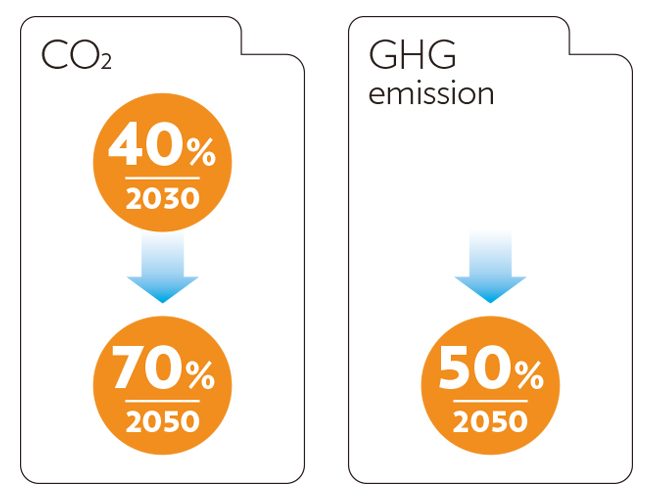 07th August 2020
07th August 2020
The clock is ticking for shipping to reduce its Green House Gas (GHG) emissions by 40 per cent before 2030 to meet targets set by the International Maritime Organization (IMO). Nowadays, shipowners operate in an environment of ever-increasing operating costs and a high level of regulation which means they must tread carefully when it comes to making a choice about which clean fuels they will adopt in the future to maintain profitability and legal compliance.
Today, there are at least 60,000 cargo ships trading globally, many of which will have an average life span of between 15 and 20 years. In order to meet the GHG reductions, new ships being built in the next few years must be designed as zero-carbon or net carbon to meet the target set by the IMO.
The main issue is that there are currently no suitable retrofitting alternatives for the existing fleet to speed up the emission reduction process which meets the target.
With the scenario, many maritime industry leaders have refocused its efforts on identifying alternative fuels that can significantly reduce emissions.
There are many different types of clean fuel that are currently being tested and evaluated by energy companies and governments, but questions still remain about bunkering, the development of engine technology to convert the fuels into energy and the most important question of all is ‘cost.’
The IMO is taking a more holistic approach to identifying alternative fuels for shipping in its IMO 4th GHG study, which includes a ‘well to wake’ approach, a term that means it will look at all emissions generated from extraction, processing to exhaust from the ship.
“There are many shipowners who are very concerned about the issue of GHG reduction, not knowing what equipment to fit or which solution will be workable for their ships. We don’t have much time – the 2030 level of ambition is to reduce carbon dioxide (CO₂) emissions per transport work by 40 per cent pursuing efforts towards 70 per cent by 2050,” said Arthur Bowring, President of the Hong Kong Arbitration Board and leading advocate for green shipping.
“The 2050 deadline is to reduce GHG emissions by at least 50 per cent for the international shipping fleet pursuing efforts towards phasing them out. It will be a challenge to reach 40 per cent reduction in CO₂ per transport work in 10 years.” said Bowring.
“It’s a concern to how we can reach 50 per cent across the entire fleet in 30 years, when we don’t yet have the workable solutions in hand. The IMO is also discussing short-term technical and operational regulatory changes, but when you see a ship designed with Flettner rotors¹ and solar panels achieving only 25 per cent reduction, it really implies there is still a long way to go” Bowring concerns.
(GHG emissions consists of Carbon Dioxide, Methane, Nitrous Oxide and Fluorinated Gases and are measured separately by the IMO.)
[¹ A Flettner ship is designed to use the Magnus effect for propulsion. The Magnus effect is a force acting on a spinning body in a moving airstream, which acts perpendicular to both the direction of the airstream and of the rotor axis.]
One of the fuels talked about most in shipping circles is Liquefied Natural Gas (LNG) which will provide a 10-15 per cent reduction in CO₂, when compared to current bunker fuel emissions, but potential methane slip² will not help GHG reductions. LNG, however, could well be a very useful springboard to other alternative fuels.

“We can forget biofuel for wide ocean-going use, also fuel cells, since to produce the power required for a large ship would weigh far more than a two-stroke engine. Even batteries for ferries and wind assisted vessels using sails won’t meet the reduction target,” concluded Bowring.
[² Methane slip or Total Hydrocarbon Emissions is the amount of methane that is not burned during the combustion process in an engine. The gas, then escapes into the atmosphere, and even a small amount methane can have a big impact on global warming.]
HYDROGEN POWER
“To my mind, hydrogen is a workable answer, there are three classes of hydrogen, depending on how it is produced – Grey Hydrogen for hydrogen production where the CO₂ is released into the air, Blue Hydrogen for production from LNG where the carbon is captured, and Green Hydrogen (H₂) where the hydrogen is produced from renewable electricity sources such as windfarms,” said Bowring.
Hydrogen can be blended with LNG to reduce emissions or used to produce ammonia (easier for storage and transport, but not great for burning) or used to make synthetic fuels. There are many reports now of Green Hydrogen facilities are being set up, which is comforting, but many more are needed, according to Bowring.
Singapore announced recently it is setting up ammonia bunkering facilities to meet expected demand as an alternative fuel.
FACTS AND NEXT STEPS
According to Klaas Visser, a Delft University of Technology (TU Delft) researcher and former marine officer, there are a few hurdles to overcome before hydrogen will be accepted. He set out the challenge the shipping industry faces.
“A great deal of energy is needed to set a large vessel into motion. A battery is not practical for many maritime applications as a result of its relatively high weight and limited range. A powerful source of energy is needed based on an efficient fuel,” he said on the TU Delft website.
Many experts, like Visser, see hydrogen as a fuel, but storage tanks full of highly flammable hydrogen puts people off. There are technical solutions that make safe storage possible – similar to the ones found for the use of natural gas on water – but the certification process is long and burdensome.
That is why scientists are looking for alternatives, in which not hydrogen itself, but a harmless raw material, such as sodium borohydride³ is utilised. This substance is used in household washing powder and produces high levels of hydrogen when it interacts with extremely clean water and a catalyst. This kind of storage could bring about a hydrogen revolution for shipping and is one of the front runners in the race to find shipping’s clean fuel.
[³ When sodium borohydride is in a strongly basic solution at or above pH 10 it reacts exothermically with water to generate flammable hydrogen gas.]
The IMO’s requirement that any fuel must be measured on its total life cycle performance in terms of emissions poses one of the greatest challenges for the producers and users of alternative energy sources for shipping.
An existing technology used to power submarines and navy vessels for decades, namely atomic power, fulfils all of these criteria and claims to be the most viable and sustainable solution to shipping’s greatest challenge.
In its latest incarnation marine Molten Salt Reactors (m-MSRs) produces ‘green sustainable fuels for smaller ships and powers the largest ships’ according to Mikal Boe, CEO of COREPOWER, the company developing the ‘atomic battery’ for ocean transportation.
According to Boe “The m-MSR is like an atomic battery pack. The unit is small with no moving parts and can be a third cheaper to run than a large fossil fueled engine, reducing waste, and is fueled-for-life, and avoids the proliferation of spent fuel. Also, it is safe and unlike atomic reactors produces no heat.”
m-MSR claims it can provide ample, sustainable and safe electric power for ships over a lifespan up to 30 years onboard with no refueling and no realistic proliferation concerns, with a closed-cycle turbine it can reach 45 per cent electrical power conversion efficiency.
“Currently, there are no immediate retrofitting options to convert ship engines from burning bunker fuel to using alternative fuels, but for the manufacturer that can find suitable solutions, I am sure there is money to be made” said Bowring.
Also, there is no one fuel that will be universally adopted by the shipping industry and Bowring says that there are bound to be different fuels or propulsion options for different ships and trades.
An important factor which will dictate which fuels will be adopted by the shipping industry are the availability of bunkering facilities and its long-term storage.
A collaborative effort is needed by the public and private sectors to ensure that sufficient funding is available for research and development (R&D), so that cleaner fuels can evolve from the laboratories to power the ships of the world.
The upside for governments is that the investment they make in R&D will benefit the public through cleaner air and a greener environment as well as creating new employment opportunities.
The question about whether owners will adopt the new cleaner fuels once available, has been answered by the recent successful introduction of Low Sulphur Fuel Oil (LSFO), which was mandated by the IMO from January this year.
“Once the alternative fuel or fuels have been introduced, the demand will increase, same as LFSO as every ship has to use them,” claims Bowring.
With the number of alternative fuels being tested and assessed, it is imperative that the right clean energy source is selected and adopted by the shipping industry to meet the targets set by the IMO. The positive signs are there that shipping and governments are combining their resources and expertise. From an environmental perspective this is the industry’s one shot to move towards a greener, cleaner maritime industry.